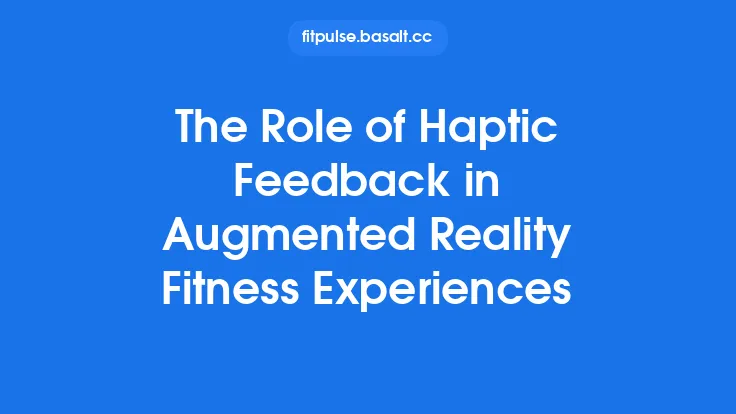Virtual fitness experiences have come a long way from simple step‑counting games to fully immersive environments that replicate a gym, a mountain trail, or a futuristic arena. As the technology matures, users and developers alike are asking a more nuanced question: how do we know we’re actually getting fitter when the workout happens behind a headset?
The answer lies in a layered set of metrics that go beyond the obvious “time spent in‑game” or “calories burned” readouts. By combining physiological data, movement analytics, engagement indicators, and longitudinal health markers, we can build a comprehensive picture of progress that is both meaningful and actionable. Below is a deep dive into the most relevant metrics, how they are captured, and why they matter for anyone serious about virtual fitness.
1. Core Physiological Metrics
1.1 Heart Rate Zones
Heart rate (HR) remains the gold standard for gauging cardiovascular effort. Modern VR/AR headsets and companion wearables (chest straps, wrist bands) can stream HR data in real time, allowing the system to calculate time spent in each zone (e.g., 50‑60 % HRmax for warm‑up, 70‑80 % HRmax for aerobic conditioning). Tracking zone distribution over weeks reveals improvements in aerobic capacity: as fitness rises, the same workout elicits a lower average HR, indicating a shift toward higher efficiency.
1.2 Heart Rate Variability (HRV)
HRV measures the variation between successive heartbeats and is a sensitive indicator of autonomic nervous system balance and recovery status. By logging nightly HRV trends alongside workout sessions, users can see whether their virtual training is over‑reaching (HRV drops) or promoting adaptation (HRV stabilizes or rises). Many platforms now integrate HRV APIs from popular health ecosystems (e.g., Apple Health, Google Fit) to enrich the feedback loop.
1.3 Oxygen Saturation (SpO₂)
Pulse oximetry, increasingly available in wrist‑worn devices, provides SpO₂ readings that can flag hypoxic stress during high‑intensity VR intervals. While not a primary performance metric, a consistent dip below 94 % during sessions may suggest the need to adjust intensity or improve breathing technique.
1.4 Metabolic Equivalents (METs)
METs estimate the energy cost of an activity relative to resting metabolism. By mapping motion capture data (e.g., joint velocity, limb acceleration) to validated MET tables, a VR system can assign a MET value to each virtual exercise. Over time, a rising average MET for a given session length signals improved work output.
2. Kinematic and Biomechanical Indicators
2.1 Range of Motion (ROM)
Accurate tracking of joint angles (hip flexion, shoulder abduction, etc.) enables the system to quantify ROM during each movement. Improvements in ROM—especially in mobility‑focused sessions—are a clear sign of increased flexibility and reduced injury risk. Advanced headsets equipped with inside‑out tracking or external sensors can capture this data without additional hardware.
2.2 Movement Quality Scores
Beyond raw ROM, algorithms can assess movement smoothness, symmetry, and timing. For example, a “squat quality score” might combine depth, knee‑over‑toe alignment, and vertical velocity profile. Consistent upward trends in these scores indicate better motor control and reduced compensatory patterns.
2.3 Power Output
Power (force × velocity) can be estimated from the combination of body mass, acceleration data, and limb kinematics. In activities like virtual boxing or rowing, tracking peak and average power per session provides a direct measure of muscular explosiveness. When paired with HR data, power‑to‑HR ratios become a sophisticated indicator of cardiovascular‑muscular efficiency.
2.4 Repetition and Set Consistency
For strength‑oriented VR workouts, counting repetitions and monitoring set consistency (rest intervals, tempo) is essential. Modern platforms can automatically log each rep, flagging incomplete or irregular sets for user review. Over weeks, a reduction in rest time while maintaining rep quality signals endurance gains.
3. Engagement and Behavioral Metrics
3.1 Session Frequency & Adherence
The simplest yet most powerful metric is how often a user logs into the virtual environment. A steady or increasing frequency (e.g., 4‑5 sessions per week) correlates strongly with long‑term health outcomes. Tracking missed sessions and identifying patterns (e.g., weekend drop‑offs) can help coaches intervene with motivational nudges.
3.2 Time‑In‑Zone vs. Time‑On‑Screen
Distinguish between total screen time and active “time‑in‑zone” (periods where HR is above a defined threshold). A user might spend 45 minutes in a session, but only 20 minutes in a true training zone. Monitoring the ratio of active to passive time helps refine workout design and ensures efficiency.
3.3 Perceived Exertion (RPE) Correlation
Many VR platforms now prompt users to rate their perceived exertion on a Borg scale after each session. Cross‑referencing RPE with objective HR and power data uncovers discrepancies that may indicate over‑ or under‑training, or simply a need for better user education on effort perception.
3.4 Progression Milestones & Badges
Gamified milestones (e.g., “Complete 10 km virtual run” or “Achieve 5 consecutive days of >30 min cardio”) serve as behavioral anchors. While not a direct fitness metric, they drive adherence and provide a tangible sense of achievement that fuels continued participation.
4. Longitudinal Health Markers
4.1 Body Composition Trends
When users sync smart scales or bio‑impedance devices, the platform can track changes in lean mass, fat percentage, and visceral fat. Coupling these trends with workout intensity data helps validate whether virtual training is translating into body composition improvements.
4.2 Resting Heart Rate (RHR)
A declining RHR over months is a classic sign of improved cardiovascular fitness. By automatically pulling RHR from wearable devices each morning, the system can plot a trend line and flag plateaus or regressions.
4.3 Sleep Quality & Recovery
Sleep duration, efficiency, and deep‑sleep proportion—available from most modern wearables—are critical recovery metrics. Correlating sleep patterns with training load (e.g., high‑intensity VR sessions) can guide periodization: a dip in deep sleep after a heavy week may suggest the need for a recovery session.
4.4 Blood Biomarkers (Optional Integration)
For users who undergo periodic lab testing, integrating biomarkers such as fasting glucose, lipid profile, or inflammatory markers (CRP) can provide a holistic view of health. While beyond the scope of most consumer VR platforms, APIs exist for health‑record integration that can enrich the data ecosystem for advanced users.
5. Data Integration & Visualization
5.1 Unified Dashboard
A well‑designed dashboard aggregates the above metrics into a single view: daily HR zone distribution, weekly ROM improvements, monthly body composition changes, and engagement heatmaps. Interactive charts allow users to drill down (e.g., click on a dip in power output to see the corresponding session video).
5.2 Trend Analysis & Predictive Insights
Machine‑learning models can detect subtle patterns—such as a gradual decline in movement quality that precedes injury. By flagging these early, the system can suggest corrective drills or a temporary reduction in load. Predictive analytics also enable personalized progression plans (e.g., “Increase interval length by 10 % next week”).
5.3 Export & Interoperability
Allowing users to export raw data (CSV, JSON) or sync with third‑party health platforms ensures transparency and empowers coaches to perform deeper analyses. Interoperability with standards like FHIR (Fast Healthcare Interoperability Resources) future‑proofs the data for potential clinical use.
6. Privacy, Security, and Ethical Considerations
Collecting granular physiological and behavioral data raises legitimate concerns. Developers must:
- Implement end‑to‑end encryption for data in transit and at rest.
- Offer granular consent controls, letting users choose which metrics are stored or shared.
- Provide clear data retention policies and easy deletion mechanisms.
- Avoid algorithmic bias by validating movement‑quality models across diverse body types and abilities.
By prioritizing privacy, platforms build trust, which in turn encourages users to share the data needed for accurate progress tracking.
7. Practical Tips for Users Who Want to Measure Real Progress
- Pair your headset with a reliable HR monitor (chest strap or wrist sensor) rather than relying solely on optical sensors built into the headset.
- Calibrate your motion capture at the start of each session—stand still for a few seconds to let the system establish a baseline.
- Log a brief post‑session RPE and note any external factors (stress, caffeine, sleep) that might affect performance.
- Schedule a monthly “benchmark” session where you repeat a standardized routine (e.g., 5‑minute virtual sprint) to compare raw power and HR data over time.
- Review the dashboard weekly, not daily. Small fluctuations are normal; trends over weeks are what matter.
- Integrate recovery metrics (sleep, HRV) into your training plan—if recovery scores dip, consider a lighter virtual workout or a mobility‑focused session.
8. The Bottom Line
Virtual fitness is no longer a novelty; it is a legitimate training modality that can deliver measurable physiological adaptations. However, the immersive nature of VR/AR can obscure the very data that traditional gyms make visible on a screen. By systematically capturing and interpreting a blend of physiological, biomechanical, behavioral, and longitudinal health metrics, users and developers can cut through the visual spectacle and focus on the numbers that truly matter.
When these metrics are presented in an intuitive, privacy‑respectful dashboard, they become powerful tools for motivation, coaching, and long‑term health improvement. In short, progress in virtual fitness is best judged not by how many virtual worlds you’ve conquered, but by how your heart rate, power output, movement quality, and overall well‑being evolve beyond the screen.



